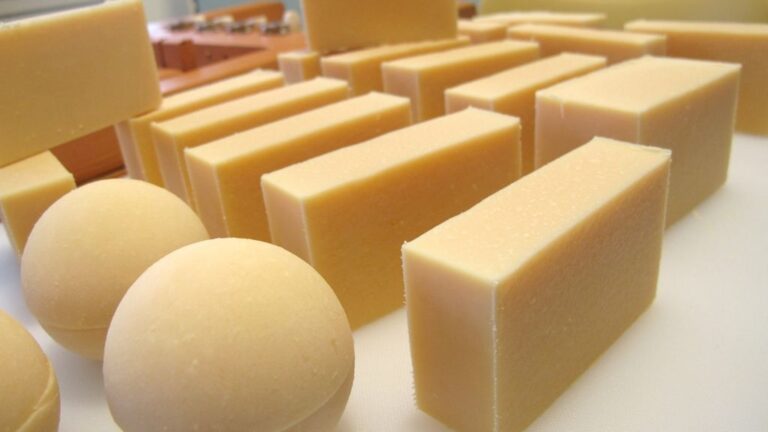You can use goat milk for a number of things, including making delicious cheesecakes,
candies, ice cream, and fudge. But did you ever think of making a rich, creamy soap out of
it? Well, if not, this article is going to convince you to give it a try, and we’ll even teach you
how to do it.
Goat milk has several health benefits, from being a source of high-quality protein to
enhancing your body’s ability to absorb nutrients from other foods. Plus, it is highly
nutritious as it contains essential vitamins and minerals, such as potassium, iron, and
vitamin A.
Now, even if you are not a fan of drinking goat milk or eating dairy products, you can still
take advantage of all the benefits goat milk has by making soap out of it.
Goat milk has multiple benefits for your skin too. For example, it has a high-fat molecule
content which makes it extremely moisturizing. Moreover, compared to the ingredients of
regular soaps, goat milk has a pH level very similar to our skin. Thus, it won’t leave your skin
irritated and dry after using it to clean your body. Moreover, goat milk is packed with skin-
friendly vitamins, including vitamins D, C and vitamin E, which will help soften your skin,
promote collagen production, and prevent aging and dry skin.
Are you ready to give it a try? Here’s how to make goat milk soap at home:
- Goat milk soap- recipe and instructions
- Although making soap using goat milk takes a little bit more preparation and time than
traditional soap recipes, we assure you that it is worth the trouble. - Depending on your resources and preferences, you can use three forms of goat milk,
including fresh milk, powdered milk, and canned milk. Each of them involves slightly
different techniques, but today we’ll teach you how to make handmade goat milk soap
using fresh milk.
What you’ll need

Before we begin to understand the exact process of making soap using goat milk, make sure
you take some time to gather the following ingredients:
- 12 ounces (340 g) of coconut oil
- 15 ounces (415 g) of olive oil
- 13 ounces (360 g) of other oils, such as palm oil
- 13 ounces (360 g) of goat milk
- 6 ounces (170 g) lye ( sodium hydroxide)
Optional:
- 1 ounce (28 g) of essential oils
- Additives such as lavender flowers or oatmeal
Additional:
- Safety equipment: goggles, gloves, and long sleeves
- Freeze the goat milk
Now that you have everything you need, you’ll need to wait a little bit more until the goat
milk freezes. Place the milk in zip-top bags and put it into the refrigerator and let it stay
there until it’s frozen and has a slushy consistency.
Mix it with lye
Once the milk is frozen, you need to break it up and place it in the pitcher to stir it until it
gets a slightly slushy consistency. As you are mixing the milk, start adding the lye, little by
little. It is recommended to wait for a few minutes between adding more lye.
Also, you can place the bowl with the frozen milk into a larger pot with cold water or ice to
keep the milk cool while mixing it with the lye.
Why is it important to mix the lye with the goat milk slowly? Because this way you prevent
the temperature of the mixture to get much higher than 90 degrees. Goat milk contains
sugars that are very sensitive and need to be kept cold to prevent them from scorching. If
you don’t keep the mixture cool, the lye will heat up and caramelizes the sugars in the milk,
resulting into a bright orange color.
Now, this isn’t necessarily a problem, but some people prefer a white bar of soap.
Once the lye/milk mixture is ready, place it ice until you prepare the oils.
Oils’ preparation
Next, you need to prepare the oils. If you are not 100% sure about the quantity of the oils,
you can use a kitchen scale to measure them.
Combine the oils in a pot and heat them slowly until they reach a temperature of nearly
110-125 degree F (43-51 °C)
Once you combine and heat the oils, it is time to slowly pour the lye/milk mixture into them
and mix by hand for about 5 minutes. If you have never made soap before, you may not
know the kind of consistency the mixture should have. Therefore, we’ll share it with you:
mix it until it reaches a thick consistency, much like pudding.
Let it sit for 24 hours
Your goat milk soap is almost done now after you have mixed all the ingredients. Next, all
you have to do is to pour the mixture into molds and let it sit for at least 24 hours before
you remove it from the molds and cut it in the desired shapes.

Wait for at least 3-4 weeks
After you cut the soap, you need to wait until the soap is suitable for you to use it on your
skin. Make sure you turn the soap bar every once in a while so that all its sides will be
exposed to air.
Next, you can use pH strips to test the soap bar. You should look for a pH between 8 and 10.
If you don’t have pH strips, you can also use the traditional “touch your tongue to it”
method. If you notice any kind of tingle on your tongue, this means that the soap bar is not
ready yet and it may be too harsh on your skin. So, wait a little bit more.








